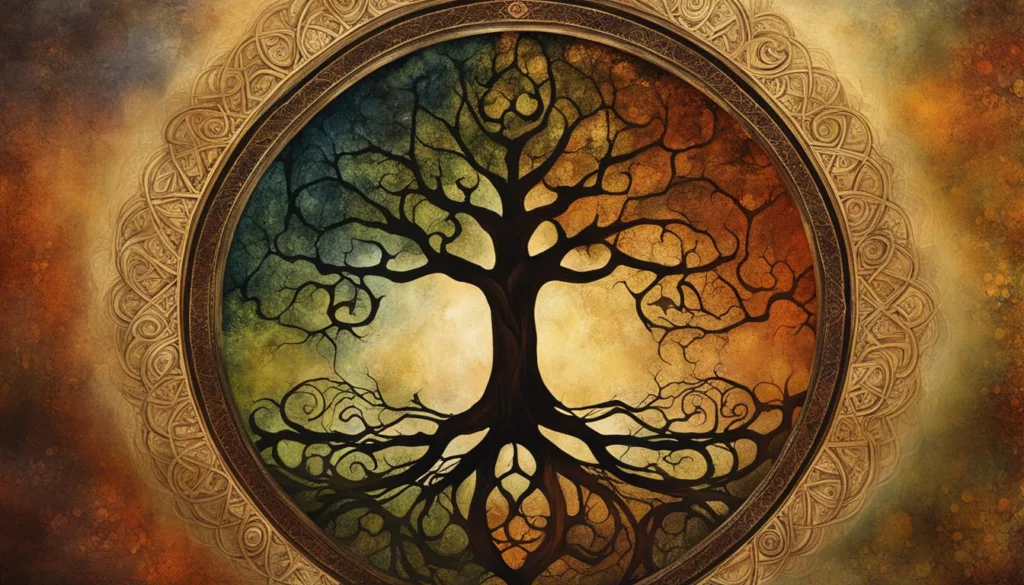Exploring Immanence: We Unearth Its Influence on Our Lives
Immanence, a concept that holds profound influence over our existence, is a philosophical idea that explores the inherent presence or manifestation of something within a specific context or framework. It challenges traditional notions of separation and transcendence, highlighting the interconnectedness and presence of the natural world within our daily experiences. Immanence is a complex concept that has important implications in various fields, including literature, art, nature, psychology, and religion.
Key Takeaways:
- Immanence explores the inherent presence or manifestation of something within a specific context or framework.
- It challenges traditional notions of separation and transcendence.
- Immanence has significant implications in literature, art, nature, psychology, and religion.
- Understanding immanence can enhance our appreciation of the richness and complexity of our existence.
- Immanence coexists with transcendence, offering different perspectives on our relationship with the world.
Immanence in Literature: Unveiling its Narrative Power
Immanence plays a significant role in literature, infusing narratives with a captivating narrative power. It encompasses the idea that stories and characters are intricately intertwined within the fabric of the narrative world. Through immanence, literature delves deep into the minds, emotions, and experiences of characters, making them integral to the storytelling process. This literary technique fosters a profound connection between readers and characters by enabling a deeper understanding of their inner worlds.
By embracing immanence in literature, authors create a realistic and authentic reading experience. Through detailed exploration of characters’ thoughts, feelings, and actions, immanence allows readers to relate to their experiences on a visceral level. By immersing readers in the characters’ lives, immanence cultivates a sense of empathy, enabling readers to connect with the narrative in a profound and meaningful way. This narrative technique captures the essence of the human experience, drawing upon the complexities of our emotions, struggles, and triumphs.
Immanence in literature allows the characters to breathe, to come alive on the pages, and to touch the hearts of readers. It is through this narrative power that literature transcends its role as mere words on a page and becomes a gateway to understanding the human condition.
Immanence in literature can be further enhanced by incorporating vivid descriptions, engaging dialogue, and intricate plot developments. By interweaving these elements, authors create a narrative tapestry that evokes a sense of presence and immediacy. Through immanence, literature transforms from a passive form of entertainment into an immersive experience that encourages readers to reflect, question, and discover new perspectives.
| Immanence in Literature: Narrative Power | Benefits |
|---|---|
| Deep exploration of characters’ thoughts, emotions, and experiences | Enhances reader empathy and connection |
| Vivid descriptions, engaging dialogue, and intricate plot developments | Creates an immersive reading experience |
| Allows characters to come alive on the pages | Transcends literature as a form of escapism |
Immanence in literature unlocks the power of storytelling, offering readers a doorway into the lives and experiences of characters. It enables profound connections, fosters empathy, and invites readers to explore the intricacies of the human condition. Through immanence, literature becomes a conduit for understanding, growth, and the discovery of our shared humanity.
Immanence in Action: “To Kill a Mockingbird” by Harper Lee
In Harper Lee’s classic novel, “To Kill a Mockingbird,” immanence serves as the cornerstone of the narrative power. The story unfolds through the eyes of Scout Finch, a young girl navigating the complexities of racial injustice in the Deep South. Lee’s masterful use of immanence enables readers to intimately experience Scout’s journey, from her innocent observations to her growing awareness of prejudice and injustice.
Through immanence, readers are transported into Scout’s world, witnessing her interactions with a vibrant cast of characters, including her father, Atticus Finch, who embodies unwavering integrity in the face of adversity. Lee’s storytelling prowess brings the themes of morality, social justice, and the loss of innocence to life. “To Kill a Mockingbird” stands as a testament to the transformative power of immanence, capturing hearts and minds with its poignant portrayal of the human experience.
Immanence in Religion: Discovering the Divine within Our Lives
Immanence holds profound significance in the realm of religion, shaping our understanding of spirituality and the divine. It entails the belief that the sacred and transcendent can be found within the natural world and human experience. Rather than viewing the divine as separate from our lives, immanence emphasizes its immanent presence and accessibility. This perspective invites us to connect with the divine in all aspects of our existence, fostering a sense of spiritual connectedness and meaning.
“Immanence in religion emphasizes the immanent presence of God or the divine in all aspects of life, rather than a transcendent God who exists outside of the world.”
Immanence in religion encompasses various theological concepts and belief systems. One such concept is divine immanence, which asserts that God is not distant or removed from the world, but is present and active within it. This idea challenges the traditional notion of a transcendent deity and instead highlights the intrinsic relationship between the divine and the natural world. Immanence in religion also intertwines with pantheism, which regards the natural world itself as divine and sacred.
The Role of Nature in Immanence
Nature holds a special place in immanence. Its beauty, complexity, and interconnectedness are seen as manifestations of the divine presence. Immanence in nature encourages us to seek spiritual experiences through engagement with the natural world, whether through observing its wonders, practicing eco-spirituality, or participating in nature-based rituals. It reminds us that nature is not merely a backdrop for our lives, but an integral part of our spiritual journey.
| Aspect | Immanence in Religion | Transcendence in Religion |
|---|---|---|
| Belief in Divine Presence | Emphasizes the immanent presence of the divine in all aspects of life. | Suggests a transcendent God who exists beyond the natural world. |
| Interconnectedness | Highlights the interconnectedness between humans, nature, and the divine. | Emphasizes a separation between the divine and the human realm. |
| Meaning and Purpose | Encourages individuals to find meaning and purpose in their everyday lives. | Focuses on finding meaning and purpose through transcendence or otherworldly realms. |
Immanence in religion offers a holistic approach to spirituality, inviting us to explore the divine within ourselves and the world around us. It encourages us to seek deeper connections and find spiritual fulfillment in our daily experiences. By embracing immanence, we can tap into a profound sense of wonder, awe, and reverence for the interconnectedness of all existence.

Immanence in Art: Exploring its Aesthetic Significance
Immanence in art holds a profound aesthetic significance, allowing us to experience a sense of immediacy and emotional connection with the artwork. It is through immanence that art has the power to evoke intense emotions and capture the essence and energy of the subject or moment depicted. Whether it’s a vibrant painting, a captivating sculpture, or a thought-provoking performance, immanence in art invites us to immerse ourselves in the artwork and engage with it on a visceral level.
One of the ways immanence manifests in art is through the use of techniques and styles that bring the subject to life, creating a sense of presence and authenticity. For example, in painting, artists may employ techniques such as vibrant brushstrokes and vivid colors to convey the energy and emotion of the scene. In sculpture, artists may use tactile materials and intricate details to make the artwork feel tangible and alive. Through these artistic choices, immanence allows us to connect with the artwork and experience a deeper understanding and appreciation for it.
“Art is the lie that enables us to realize the truth.” – Pablo Picasso
Immanence in art also enables us to explore different perspectives and interpretations. Each viewer brings their own unique experiences and emotions to the artwork, creating a personal connection that goes beyond the surface. It is through this subjective experience that immanence reveals the diversity of human perception and enriches our understanding of the artwork and ourselves.
| Art Form | Characteristic |
|---|---|
| Painting | Vibrant brushstrokes, vivid colors |
| Sculpture | Tactile materials, intricate details |
| Photography | Capturing fleeting moments, unique perspectives |
| Performance Art | Engaging the audience, immersive experiences |
Immanence in art, with its ability to evoke emotions, capture the essence of the subject, and invite personal interpretations, enriches our cultural experience and deepens our connection to the artistic world. It urges us to explore the vast array of artistic expressions and find meaning in the beauty and complexity of the artwork that surrounds us.
The Significance of Immanence in Art Forms:
- Immanence in painting allows for the expression of emotions through vibrant brushstrokes and vivid colors, creating a dynamic and engaging visual experience.
- In sculpture, immanence is brought to life through tactile materials and intricate details, enabling the artwork to evoke a sense of presence and authenticity.
- Immanence in photography captures fleeting moments and unique perspectives, inviting viewers to see the world through the artist’s lens.
- Performance art embraces immanence by engaging the audience and creating immersive experiences that blur the boundaries between art and reality.
Immanence in art is a powerful force that enables us to connect with the artwork, explore different perspectives, and appreciate the beauty and complexity of the artistic world. It enriches our lives by allowing us to experience the depth and immediacy of artistic creation.
Immanence in Nature: Discovering its Beauty and Harmony
Immanence in nature brings to light the inherent beauty and harmony that exists within the natural world. It is a recognition of the interconnectedness and interdependence between humans and the environment we inhabit. When we delve into the depths of nature, we uncover a tapestry of diverse ecosystems, breathtaking landscapes, and intricate ecological systems that weave together to create a harmonious whole.
As we immerse ourselves in nature, we gain a profound appreciation for its raw beauty and the delicate balance that sustains it. From the vibrant hues of a sunset to the rhythmic sound of crashing waves, immanence in nature draws us into the present moment, allowing us to experience a deep sense of awe and wonder.
“In every walk with nature, one receives far more than he seeks.” – John Muir
The quote by John Muir encapsulates the transformative power of immersing oneself in nature. It highlights how nature has the ability to nourish our souls, to ignite our senses, and to inspire us in profound ways. It is through immanence in nature that we can find solace, restoration, and a reconnection with our own inner rhythms.
By embracing immanence in nature, we develop a deeper understanding of our place in the world and our responsibility to protect and preserve it. It reminds us of the reciprocal relationship we share with the natural environment and the importance of practicing sustainable living.
Table: The Beauty of Immanence in Nature
| Aspect | Description |
|---|---|
| Biodiversity | The wide variety of plant and animal species that coexist in a habitat, contributing to the health and resilience of ecosystems. |
| Ecosystem Services | The benefits provided by ecosystems, including clean air and water, pollination, climate regulation, and the provision of food and natural resources. |
| Interconnectedness | The intricate web of relationships between different species and elements within an ecosystem, highlighting the importance of maintaining ecological balance. |
| Scenic Beauty | The captivating landscapes and awe-inspiring vistas that nature offers, providing a source of inspiration and tranquility. |
| Harmony | The balance and equilibrium that exists within natural systems, promoting a state of equilibrium and sustainability. |
Immanence in nature invites us to be mindful of our surroundings, to be stewards of the environment, and to cultivate a deep sense of gratitude for the wonders of the natural world. By immersing ourselves in nature’s embrace, we can foster a greater connection with the earth and awaken a profound sense of reverence for all living beings.

In conclusion, immanence in psychology urges us to embrace the interconnectedness of our experiences, thoughts, and emotions. It compels us to recognize the significance of our subjective reality in shaping our psychological well-being. By exploring our beliefs, values, and emotions, we cultivate self-awareness and authenticity. Immanence in psychology also underscores the importance of considering the dynamic relationship between individuals and their environment in promoting holistic mental health.
Conclusion
In conclusion, immanence and transcendence offer contrasting perspectives on our relationship with the world. While immanence emphasizes the inherent presence and interconnectedness of the natural world within our daily experiences, transcendence suggests the existence of something beyond the material realm. Both concepts coexist and shape different aspects of our lives.
Immanence influences literature by immersing readers in the characters’ inner worlds, creating a sense of realism and authenticity. It is also present in religious and spiritual beliefs, highlighting the immanent presence of the divine within all aspects of life. In the world of art, immanence evokes intense emotions and allows viewers to connect with artwork on a visceral level. In nature, immanence reveals the beauty, harmony, and interdependence that exist within the natural environment.
In psychology, immanence emphasizes the interconnectedness of our experiences, thoughts, and emotions, fostering self-awareness and authenticity. While immanence and transcendence may seem contradictory, they provide different perspectives that enhance our understanding of the richness and complexity of our existence.
By exploring immanence, we can gain a deeper appreciation for the world around us, recognize our place within it, and cultivate a greater sense of connection with ourselves and others. Immanence invites us to embrace the beauty and interconnectedness of our experiences, leading to a more holistic and meaningful understanding of our lives.
FAQ
What is immanence?
Immanence is a philosophical concept that explores the inherent presence or manifestation of something within a specific context or framework.
How does immanence affect literature?
Immanence in literature shapes the narrative power of a story by deeply embedding the characters within the world of the narrative, allowing readers to connect with them on a deeper level.
What is the role of immanence in religion and spirituality?
Immanence in religion emphasizes the belief that the divine or sacred is present and accessible within the natural world and human experience, highlighting the interconnectedness of the spiritual and material.
How does immanence influence art?
Immanence in art evokes intense emotions and creates a sense of immediacy and presence, allowing viewers to connect with the artwork on a visceral and emotional level.
What does immanence in nature refer to?
Immanence in nature recognizes the inherent presence of beauty, harmony, and interconnectedness within the natural world, emphasizing the interdependence between humans and the environment.
How does immanence impact psychology?
Immanence in psychology emphasizes the interconnectedness and interplay between our experiences, thoughts, and emotions, highlighting the significance of personal experiences in shaping our psychological well-being.






